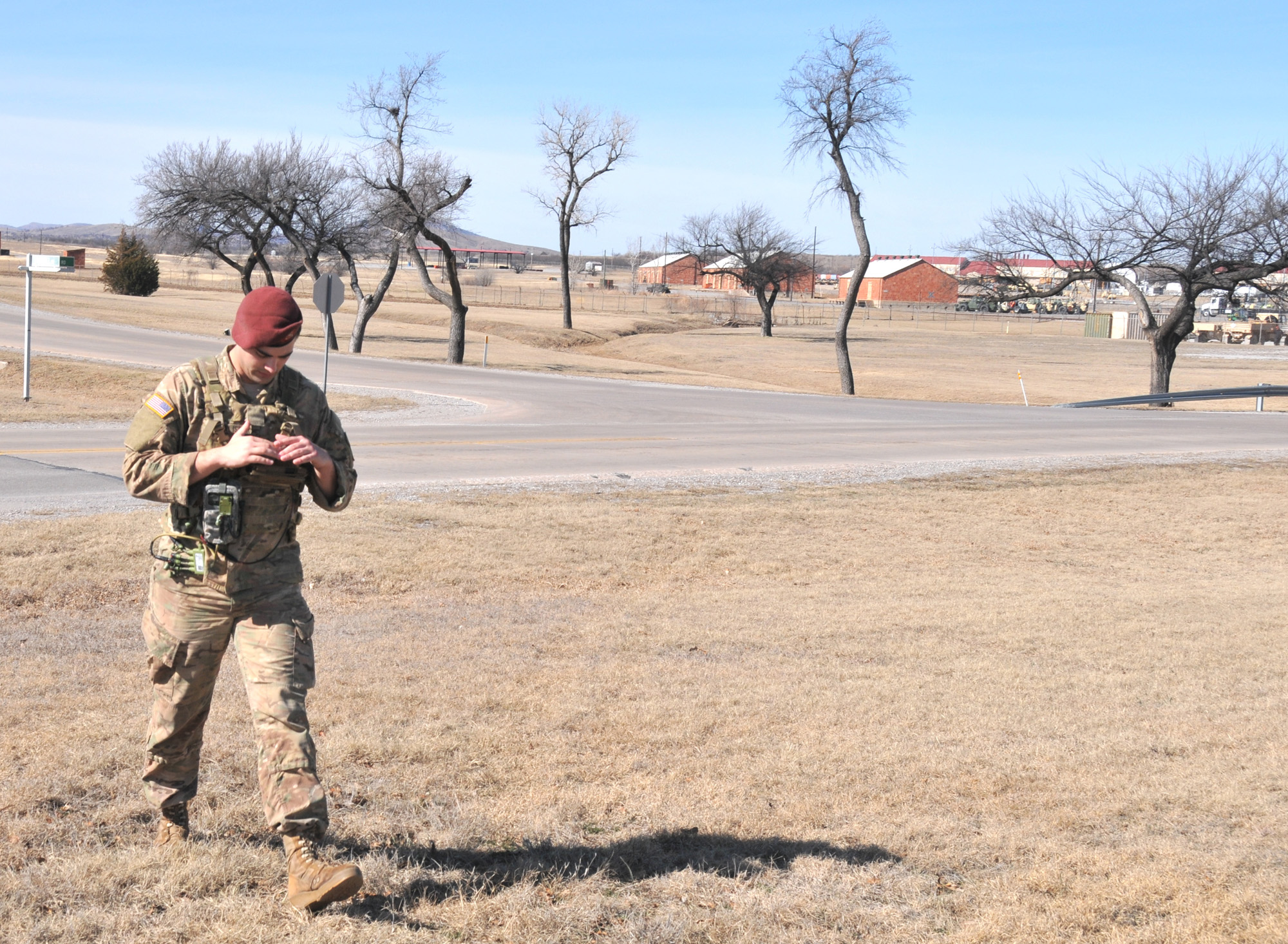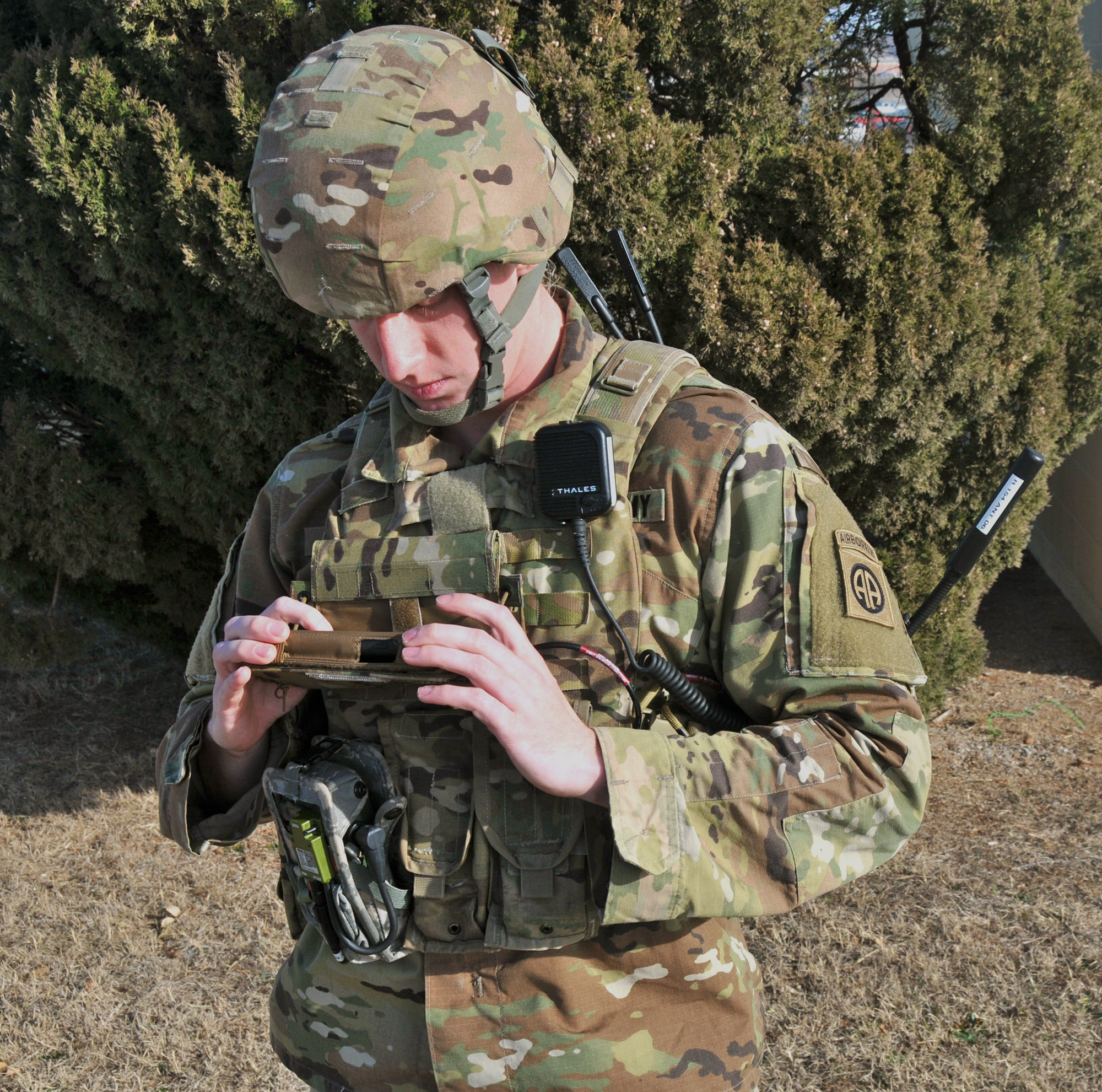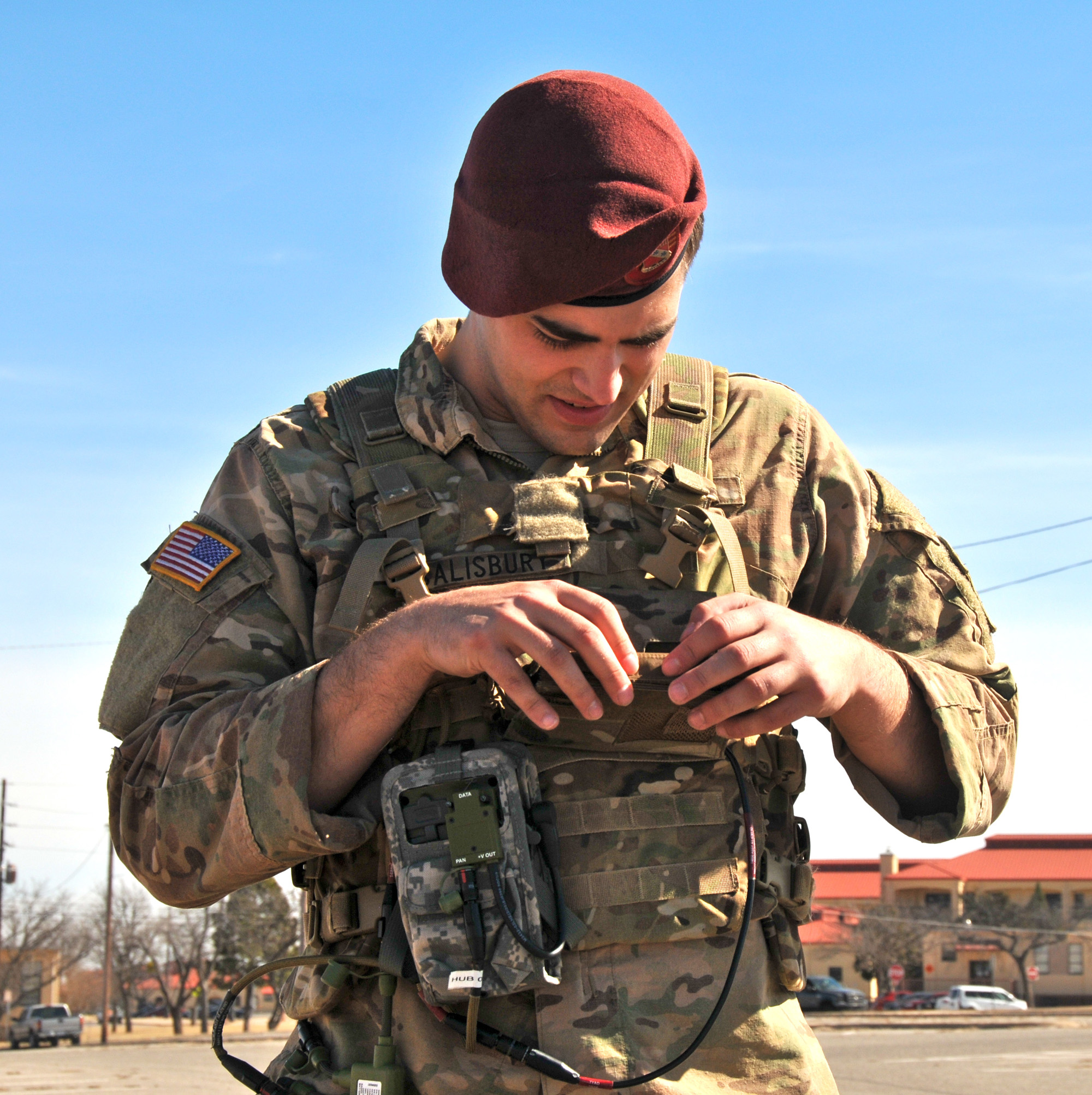
By Dan Lafontaine, PEO C3T Public Affairs
FORT SILL, Okla. — Soldiers view live-stream full-motion video from unmanned aerial vehicles via a smartphone. They access 3D digital maps to send precision target coordinates. Soldiers are relying on these advanced technologies to improve lethality and maintain battlefield dominance.
These are among the improvements that will be embedded in future fire-support capabilities.
The Army has started testing four upgraded systems for its Field Artillery units to provide more accurate and timely fire support to maneuver formations. Fielding is scheduled to begin in fall 2017.
“These improved capabilities allow us to be lighter, faster and more lethal by optimizing the sensor-to-shooter digital chain,” said Lt. Col. Kevin Taylor, commander of 3rd Battalion, 319th Field Artillery Regiment, 1st Brigade Combat Team, 82nd Airborne Division (Artillery). “They assist us in providing faster, more accurate firing data to our cannon crews, enhancing our effectiveness on the battlefield.”
Nineteen Soldiers from Fort Bragg, North Carolina, recently completed three weeks of classroom and field training and assessments at Fort Sill. They are the first group of Soldiers to place the fire mission systems through rigorous testing.
UPGRADED SYSTEMS DELIVER IMPROVED CAPABILITIES
The Precision Fires-Dismounted system has undergone the most significant changes. The hardware is smaller, lighter and less expensive through its transition to a software application hosted on the Nett Warrior End User Device, an Android-enabled smartphone. PF-D is the first major program of record on Nett Warrior.

(From left) Spc. Garrett Salisbury, Neil Vestermark and Markes Jackson discuss the Precision Fires-Dismounted system, a software application hosted on the Nett Warrior End User Device, Feb. 6 at Fort Sill, Oklahoma. (Photo Credit: Dan Lafontaine (PEO C3T))
The new PF-D has greatly expanded the ability of forward observers to conduct completely digital calls for fire, which provides Field Artillery Soldiers with precise target location coordinates derived from imagery. Commanders then gain more accurate digital fires solutions, which are vital for conducting precision targeting in urban areas where collateral damage is a major concern because of close proximity, Taylor said.
Digital communications also greatly reduces transmission error, with significantly less intervention than when using voice commands, according to Chief Warrant Officer 4 Robert Stoll, operational test officer with the Fires Test Directorate at Fort Sill.
Lt. Col. Chris Anderson is the product manager for Fire Support Command and Control at Aberdeen Proving Ground, Maryland. He oversees the development, testing and fielding for these projects under Program Executive Office Command, Control and Communications-Tactical.
“Because they were going to be the first unit equipped with PF-D, the 82nd Airborne agreed to send their Soldiers for this test, and we’re grateful for their participation. PF-D really is a revolutionary capability, not just evolutionary. It greatly improves situational awareness and targeting capability for forward observers on the ground,” Anderson said. “It was a sacrifice for the unit to have their troopers on the road for this amount of time, but in return they got almost a month of hands-on dedicated training.
“The 82nd gets back Soldiers who have been pounding on these systems in support of this test, and are experts now going back to the unit. They’ll have embedded expertise when the equipment hits the field.”
A combination of hardware and software improvements make up the upgrades to the other three systems:
- Advanced Field Artillery Tactical Data System provides fully automated support for planning, executing and delivering fires and effects, and controls weapon systems such as mortars, field artillery cannons, rockets and missiles, close air support, attack aviation and naval surface fire support systems. The software upgrade adds counter-fire target lists for functionality and updated munitions.
- Joint Automated Deep Operations Coordination System functions as a complementary system to AFATDS that is fielded to joint and coalition units, primary at the division level. Using JADOCS, commanders can coordinate the joint execution of fires across the battlefield.
- Profiler Virtual Module is the replacement for the Profiler Meteorological Data Computer. The Profiler system automates the collection of digital meteorological data to AFATDS operators. Current and accurate wind speed and direction are necessary to ensure rounds hit their targets, which is important for both precision and conventional munitions.
First Lt. Matthew Ray, a Field Artillery officer, served as officer-in-charge during the Soldiers’ testing. The first week was classroom instruction, followed by technical testing and reviewing Army field manuals, and finally live tests to provide feedback to the developers, engineers and instructors.
Sgt. Sean Weekley, an AFATDS specialist, has worked on the system for five years and said the upgrades provide more capabilities for artillery.

Spc. Garrett Salisbury trains on the Precision Fires-Dismounted system, a software application hosted on the Nett Warrior End User Device, Feb. 6 at Fort Sill, Oklahoma. (Photo Credit: Dan Lafontaine (PEO C3T))
“With the training we’ve done here on the new software, we’re trying to learn everything as quickly as we can and retain that knowledge. When we get back to our units, we can show them the changes,” Weekley said.
Spc. Walter Jones, a fire support specialist with two years of service, used the training to better understand how the Field Artillery systems integrate.
“It’s really interesting to see all the systems in the same room and immediately know how they function with each other. If I’m sitting in a tactical operations center, I know what I’m doing on my end, but it’s hard to imagine the whole picture to see how it all works together. I’ve gotten exposure to systems that I normally wouldn’t,” Jones said.
HUMAN-FACTORS ASSESSMENTS
Understanding how Army research and engineering eventually transitions into the hands of Soldiers is an essential part of these updated command and control systems for the Field Artillery, Anderson said.
Research psychologist Dr. Pam Savage-Knepshield is embedded in Fire Support Command and Control office, and she brings expertise in studying how Soldiers interact with the technology being tested and fielded by the Army. She works directly with Soldiers through interviews, surveys and observation to understand their needs, priorities and how they use technology.

Sgt. Nathaniel Shaver trains on the Precision Fires-Dismounted system, a software application hosted on the Nett Warrior End User Device, Feb. 7 at Fort Sill, Oklahoma. (Photo Credit: Dan Lafontaine (PEO C3T))
Savage-Knepshield conducted early user assessments of the updated PF-D in August 2016 with 82nd Airborne Soldiers to identify usability issues before development was complete. She analyzed their feedback and then designed a survey to compare that data with responses being collected in January and February.
“Usability has moved to the forefront. Everyone is expecting things to be easy to use,” she said. “Soldiers are asking, ‘Why do things have to be this hard?’
“I focus on Soldier-centered design. You have to get Soldiers involved in the process very early on to understand their needs. What do they need? How do they expect things to work? What are they using now? That drives their expectations. We should be leveraging in our system design what they already know from working with the systems. They can transfer their training and experiences to what they’re going to be using.”
Obtaining Soldiers’ feedback early in the development process ensures that engineers and test officers are not learning of usability issues after it is too late for fixes to be implemented, Anderson said.
“The Soldiers in August gave us a lot of input. We gave that information to the developers and refined the software in the user interface so it would work better for Soldiers,” Anderson said.
Savage-Knepshield first looks at the intent of the equipment and how Soldiers will use it to accomplish their missions. She measures Soldiers’ cognitive workload as it relates to equipment design and functionality.

Sgt. Nathaniel Shaver trains on the Precision Fires-Dismounted system, a software application hosted on the Nett Warrior End User Device, Feb. 7 at Fort Sill, Oklahoma. (Photo Credit: Dan Lafontaine (PEO C3T))
Based on the usability criteria, she is able to develop a ranking of Soldiers’ preferred capabilities as well as their thoughts on likely risk factors. Based on her analysis of the data and recommendations, the project officers and engineers can determine what is feasible and cost effective.
“If it’s designed well, that should meet the needs. We have to be as good or better than voice when we’re building it digitally for speed, reliability and use of ease,” Savage-Knepshield said. “I work for the Soldiers. I’m here to serve them and help them get the best possible equipment.
“I work to make visible what is invisible in their heads.”
COMBINED CUSTOMER TEST
Ray said that testing the four systems concurrently helps to ensure they work well together while identifying glitches sooner.
“The benefit of a combined test is typically things would get approved individually and pushed out to the force,” he said. “Soldiers then find out they don’t operate well with other systems. All the systems are connected for digital fires. This test saves time, and therefore, money on the battlefield.”

Spc. Garrett Salisbury trains on the Precision Fires-Dismounted system, a software application hosted on the Nett Warrior End User Device, Feb. 6 at Fort Sill, Oklahoma. (Photo Credit: Dan Lafontaine (PEO C3T))
Anderson said it took a significant amount of coordination to synch a test plan for four programs with separate development timelines, but the effort was well worth it.
“It’s more efficient for the project office and testers. It’s more operationally realistic to have live Soldiers behind live systems in the test. It’s not simulations; this is how we fight in a networked digital sensor-to-shooter chain,” Anderson said. “Getting them all aligned to go to an operational test at the same time means we didn’t have to get four separate test units, testers and data collectors. That’s a huge efficiency for the product office and Army Test and Evaluation Command, but more importantly it makes for a much more realistic operational test environment.”
Taylor said the training better enables his Soldiers to contribute to the future employment of these systems throughout the Army.
“We have the ability to conduct invaluable training while providing critical feedback for improving such systems, which will ultimately enhance readiness. We want to ensure we get the process right as early as possible in order to make the fire support community and the Army better as a whole,” Taylor said.
This article was originally posted on Army.mil.
Subscribe to Army AL&T News, the premier online news source for the Acquisition, Logistics, and Technology (AL&T) Workforce.







